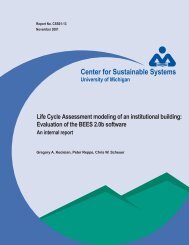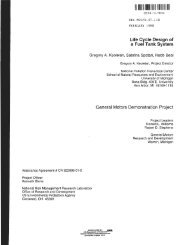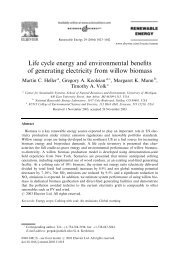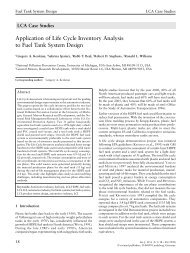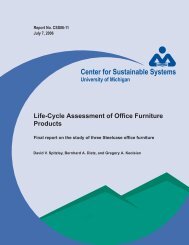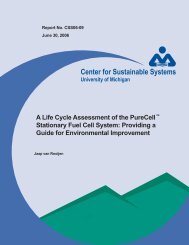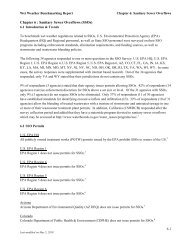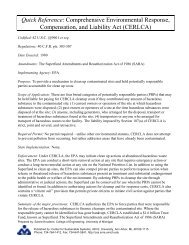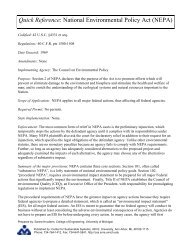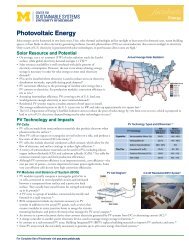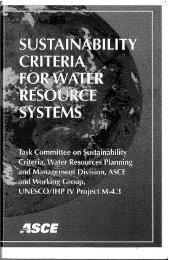Life Cycle Optimization of Residential Air Conditioner Replacement
Life Cycle Optimization of Residential Air Conditioner Replacement
Life Cycle Optimization of Residential Air Conditioner Replacement
Create successful ePaper yourself
Turn your PDF publications into a flip-book with our unique Google optimized e-Paper software.
The overall demand for space cooling stands to increase due to high population growth inregions with hot climates. Table 1.1 shows the four states projected to grow the fastest are alsoamong the states with the highest cooling degree days (using a base 65°F). A cooling degree day(CDD) is a measure <strong>of</strong> the cooling demand <strong>of</strong> a climate. It is calculated by summing the number<strong>of</strong> degrees the average daily temperature exceeds the base temperature over the course <strong>of</strong> ayear.Table 1.1: Cooling Load <strong>of</strong> States with Fastest Population Growth (US Census Bureau,2005; NCDC, 2002)Projected Growth Rate(2000-2030)Average PopulationWeighted Cooling DegreeDaysRanking <strong>of</strong> States withHighest Average CoolingDegree DaysNevada 114.3 % 1921 7Arizona 108.8 % 2861 3Florida 79.5 % 3420 1Texas 59.8 % 2648 4These four states alone account for about 40% <strong>of</strong> the projected growth in the US populationfrom 2000 to 2030. If these projections are correct, the average American will go from living ina 1250 CDD climate in 2000 to a 1360 CDD climate by 2030. This assumes that climate patternswill remain stable in the coming decades. The prospect <strong>of</strong> higher summertime temperaturesresulting from climate change would further increase the amount <strong>of</strong> cooling required. Climatechange also stands to increase the saturation <strong>of</strong> air conditioning as households that previouslyhad no air conditioning equipment become unwilling to deal with higher summer temperatures(Sailor & Pavlova, 2003).1.2 History <strong>of</strong> Federal StandardsBeginning in the 1970’s various states began implementing their own minimum efficiencystandards for appliances. The Energy Policy and Conservation Act <strong>of</strong> 1975 called for nationalappliance efficiency targets. The National Appliance Energy Conservation Act <strong>of</strong> 1987established national standards for several classes <strong>of</strong> household appliances including room andcentral air conditioners and called for the Department <strong>of</strong> Energy to review and revise thestandards in the future (DOE, 2008). Central air conditioner (CAC) efficiency is usually measuredby the seasonal energy efficiency ratio (SEER), which represents the average number <strong>of</strong> BTUs <strong>of</strong>cooling per Wh <strong>of</strong> electricity input over a typical cooling season. The initial efficiency level wasset at 10 SEER and took effect for split system CACs manufactured on or after January 1, 1992.The Department <strong>of</strong> Energy published a revised standard for CACs on January 22, 2001 whichtook effect in January 2006. This new rule raised federal energy efficiency standards 30% to 13SEER. As Figure 1.4 shows, this change has significantly boosted the average efficiency <strong>of</strong>central air conditioners being sold. It continued to increase very gradually after the federalstandard was implemented. According to the US Department <strong>of</strong> Energy, this more stringentstandard will save 4.2 quads (quadrillion BTUs) <strong>of</strong> energy by 2030 (DOE, 2005). A new rulemaking process is currently underway with a final rule to be established by June 2011, which willtake effect in June <strong>of</strong> 2016 (DOE, 2008).



